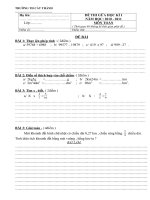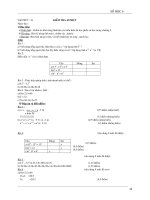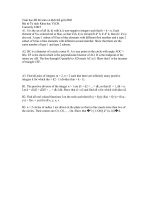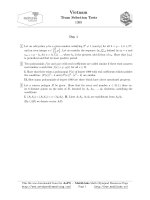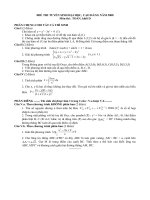Tài liệu Đề thi toán khu vực 1999-2009 pdf
Bạn đang xem bản rút gọn của tài liệu. Xem và tải ngay bản đầy đủ của tài liệu tại đây (991.55 KB, 22 trang )
Vietnam
Team Selection Tests
1999
Day 1
1 Let an odd prime p be a given number satisfying 2
h
= 1 (mod p) for all h < p − 1, h ∈ N
∗
,
and an even integer a ∈
p
2
, p
. Let us consider the sequence {a
n
}
∞
n=0
defined by a
0
= a and
a
n+1
= p − b
n
for n = 0, 1, 2, . . ., where b
n
is the greatest odd divisor of a
n
. Show that {a
n
}
is periodical and find its least positive period.
2 Two polynomials f (x) and g(x) with real coefficients are called similar if there exist nonzero
real number a such that f (x) = q · g(x) for all x ∈ R.
I. Show that there exists a polynomial P (x) of degree 1999 with real coefficients which satisfies
the condition: (P (x))
2
− 4 and (P
(x))
2
· (x
2
− 4) are similar.
II. How many polynomials of degree 1999 are there which have above mentioned property.
3 Let a convex polygon H be given. Show that for every real number a ∈ (0, 1) there ex-
ist 6 distinct points on the sides of H, denoted by A
1
, A
2
, . . . , A
6
clockwise, satisfying the
conditions:
I. (A
1
A
2
) = (A
5
A
4
) = a · (A
6
A
3
). II. Lines A
1
A
2
, A
5
A
4
are equidistant from A
6
A
3
.
(By (AB) we denote vector AB)
/>This file was downloaded from the AoPS − MathLinks Math Olympiad Resources Page
Page 1 />vnmath.com
Vietnam
Team Selection Tests
1999
Day 2
1 Let a sequence of positive reals {u
n
}
∞
n=1
be given. For every positive integer n, let k
n
be the
least positive integer satisfying:
k
n
i=1
1
i
≥
n
i=1
u
i
.
Show that the sequence
k
n+1
k
n
has finite limit if and only if {u
n
} does.
2 Let a triangle ABC inscribed in circle Γ be given. Circle Θ lies in angle of triangle and
touches sides AB, AC at M
1
, N
1
and touches internally Γ at P
1
. The points M
2
, N
2
, P
2
and
M
3
, N
3
, P
3
are defined similarly to angles B and C respectively. Show that M
1
N
1
, M
2
N
2
and
M
3
N
3
intersect each other at their midpoints.
3 Let a regular polygon with p vertices be given, where p is an odd prime number. At every
vertex there is one monkey. An owner of monkeys takes p peanuts, goes along the perimeter
of polygon clockwise and delivers to the monkeys by the following rule: Gives the first peanut
for the leader, skips the two next vertices and gives the second peanut to the monkey at the
next vertex; skip four next vertices gives the second peanut for the monkey at the next vertex
... after giving the k-th peanut, he skips the 2 · k next vertices and gives k + 1-th for the
monkey at the next vertex. He does so until all p peanuts are delivered.
I. How many monkeys are there which does not receive peanuts? II. How many edges
of polygon are there which satisfying condition: both two monkey at its vertex received
peanut(s)?
/>This file was downloaded from the AoPS − MathLinks Math Olympiad Resources Page
Page 2 />vnmath.com
Vietnam
Team Selection Tests
2000
Day 1
1 Two circles C
1
and C
2
intersect at points P and Q. Their common tangent, closer to P than
to Q, touches C
1
at A and C
2
at B. The tangents to C
1
and C
2
at P meet the other circle at
points E = P and F = P , respectively. Let H and K be the points on the rays AF and BE
respectively such that AH = AP and BK = BP . Prove that A, H, Q, K, B lie on a circle.
2 Let k be a given positive integer. Dene x
1
= 1 and, for each n > 1, set x
n+1
to be the smallest
positive integer not belonging to the set {x
i
, x
i
+ ik|i = 1, ..., n}. Prove that there is a real
number a such that x
n
= [an] for all n ∈ N.
3 Two players alternately replace the stars in the expression
∗x
2000
+ ∗x
1999
+ ... + ∗x + 1
by real numbers. The player who makes the last move loses if the resulting polynomial has a
real root t with |t| < 1, and wins otherwise. Give a winning strategy for one of the players.
/>This file was downloaded from the AoPS − MathLinks Math Olympiad Resources Page
Page 1 />vnmath.com
Vietnam
Team Selection Tests
2000
Day 2
1 Let a, b, c be pairwise coprime natural numbers. A positive integer n is said to be stubborn
if it cannot be written in the form n = bcx + cay + abz, for some x, y, z ∈ N. Determine the
number of stubborn numbers.
2 Let a > 1 and r > 1 be real numbers. (a) Prove that if f : R
+
→ R
+
is a function satisfying
the conditions (i) f(x)
2
≤ ax
r
f(
x
a
) for all x > 0, (ii) f(x) < 2
2000
for all x <
1
2
2000
, then
f(x) ≤ x
r
a
1−r
for all x > 0. (b) Construct a function f : R
+
→ R
+
satisfying condition (i)
such that for all x > 0, f(x) > x
r
a
1−r
.
3 A collection of 2000 congruent circles is given on the plane such that no two circles are tangent
and each circle meets at least two other circles. Let N be the number of points that belong
to at least two of the circles. Find the smallest possible value of N.
/>This file was downloaded from the AoPS − MathLinks Math Olympiad Resources Page
Page 2 />vnmath.com
Vietnam
Team Selection Tests
2001
Day 1
1 Let a sequence of integers {a
n
}, n ∈ N be given, defined by
a
0
= 1, a
n
= a
n−1
+ a
[n/3]
for all n ∈ N
∗
.
Show that for all primes p ≤ 13, there are infinitely many integer numbers k such that a
k
is
divided by p. (Here [x] denotes the integral part of real number x).
2 In the plane let two circles be given which intersect at two points A, B; Let P T be one of the
two common tangent line of these circles (P, T are points of tangency). Tangents at P and T
of the circumcircle of triangle AP T meet each other at S. Let H be a point symmetric to B
under P T . Show that A, S, H are collinear.
3 Some club has 42 members. Its known that among 31 arbitrary club members, we can find
one pair of a boy and a girl that they know each other. Show that from club members we
can choose 12 pairs of knowing each other boys and girls.
/>This file was downloaded from the AoPS − MathLinks Math Olympiad Resources Page
Page 1 />vnmath.com
Vietnam
Team Selection Tests
2001
Day 2
1 Lets consider the real numbers a, b, c satisfying the condition
21 · a · b + 2 · b · c + 8 · c · a ≤ 12.
Find the minimal value of the expression
P (a, b, c) =
1
a
+
1
b
+
1
c
.
2 Let an integer n > 1 be given. In the space with orthogonal coordinate system Oxyz we
denote by T the set of all points (x, y, z) with x, y, z are integers, satisfying the condition:
1 ≤ x, y, z ≤ n. We paint all the points of T in such a way that: if the point A(x
0
, y
0
, z
0
) is
painted then points B(x
1
, y
1
, z
1
) for which x
1
≤ x
0
, y
1
≤ y
0
and z
1
≤ z
0
could not be painted.
Find the maximal number of points that we can paint in such a way the above mentioned
condition is satisfied.
3 Let a sequence {a
n
}, n ∈ N
∗
given, satisfying the condition
0 < a
n+1
− a
n
≤ 2001
for all n ∈ N
∗
Show that there are infinitely many pairs of positive integers (p, q) such that p < q and a
p
is
divisor of a
q
.
/>This file was downloaded from the AoPS − MathLinks Math Olympiad Resources Page
Page 2 />vnmath.com
Vietnam
Team Selection Tests
2002
Day 1
1 Find all triangles ABC for which ∠ACB is acute and the interior angle bisector of BC
intersects the trisectors (AX, (AY of the angle ∠BAC in the points N, P respectively, such
that AB = NP = 2DM , where D is the foot of the altitude from A on BC and M is the
midpoint of the side BC.
2 On a blackboard a positive integer n
0
is written. Two players, A and B are playing a game,
which respects the following rules:
− acting alternatively per turn, each player deletes the number written on the blackboard n
k
and writes instead one number denoted with n
k+1
from the set
n
k
− 1,
n
k
3
;
− player A starts first deleting n
0
and replacing it with n
1
∈
n
0
− 1,
n
0
3
;
− the game ends when the number on the table is 0 - and the player who wrote it is the
winner.
Find which player has a winning strategy in each of the following cases:
a) n
0
= 120;
b) n
0
=
3
2002
− 1
2
;
c) n
0
=
3
2002
+ 1
2
.
3 Let m be a given positive integer which has a prime divisor greater than
√
2m + 1. Find the
minimal positive integer n such that there exists a finite set S of distinct positive integers
satisfying the following two conditions:
I. m ≤ x ≤ n for all x ∈ S;
II. the product of all elements in S is the square of an integer.
/>This file was downloaded from the AoPS − MathLinks Math Olympiad Resources Page
Page 1 />vnmath.com
Vietnam
Team Selection Tests
2002
Day 2
1 Let n ≥ 2 be an integer and consider an array composed of n rows and 2n columns. Half of
the elements in the array are colored in red. Prove that for each integer k, 1 < k ≤
n
2
+ 1,
there exist k rows such that the array of size k × 2n formed with these k rows has at least
k!(n − 2k + 2)
(n − k + 1)(n − k + 2)··· (n − 1)
columns which contain only red cells.
2 Find all polynomials P (x) with integer coefficients such that the polynomial
Q(x) = (x
2
+ 6x + 10) · P
2
(x) − 1
is the square of a polynomial with integer coefficients.
3 Prove that there exists an integer n, n ≥ 2002, and n distinct positive integers a
1
, a
2
, . . . , a
n
such that the number N = a
2
1
a
2
2
··· a
2
n
− 4(a
2
1
+ a
2
2
+ ··· + a
2
n
) is a perfect square.
/>This file was downloaded from the AoPS − MathLinks Math Olympiad Resources Page
Page 2 />vnmath.com


